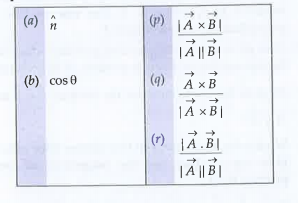If →m,→n,→r are three vectors, θ is the angle between the vectors →mand→n, what is mnr cos θ equal to ?
(→m.→n)(→r.(→r/r))
(→m.→n)(→r.→r)
(→m.→r)(→n.(→n/n))
(→m.→n)→r
The correct Answer is:D
To solve the problem, we need to find the expression for mnrcosθ where →m and →n are two vectors and θ is the angle between them.
1. Understanding the Dot Product:
The cosine of the angle θ between two vectors →m and →n can be expressed using the dot product:
cosθ=→m⋅→n|→m||→n|
2. Rearranging the Equation:
From the above equation, we can rearrange it to find →m⋅→n:
→m⋅→n=|→m||→n|cosθ
3. Substituting Values:
Let |→m|=m and |→n|=n. Therefore, we can write:
→m⋅→n=mncosθ
4. Incorporating the Third Vector:
Now, we need to consider the third vector →r. We want to find mnrcosθ:
mnrcosθ=(mncosθ)r
5. Final Expression:
Since we have already established that →m⋅→n=mncosθ, we can express mnrcosθ as:
mnrcosθ=→m⋅→n⋅r
Conclusion:
Thus, the expression mnrcosθ is equal to →m⋅→n⋅r.
The cosine of the angle θ between two vectors →m and →n can be expressed using the dot product:
cosθ=→m⋅→n|→m||→n|
From the above equation, we can rearrange it to find →m⋅→n:
→m⋅→n=|→m||→n|cosθ
Let |→m|=m and |→n|=n. Therefore, we can write:
→m⋅→n=mncosθ
Now, we need to consider the third vector →r. We want to find mnrcosθ:
mnrcosθ=(mncosθ)r
Since we have already established that →m⋅→n=mncosθ, we can express mnrcosθ as:
mnrcosθ=→m⋅→n⋅r
Thus, the expression mnrcosθ is equal to →m⋅→n⋅r.
Topper's Solved these Questions
Similar Questions
Knowledge Check
If θ be the angle between two vectors →a and →b, then →a.→b≥0 only when
A0<θ<π2B0≤θ≤π2C0<θ<πD0≤θ≤πIf →u and →v are unit vectors and θ is the actue angle between them, then 2→u×3→v is a unit vector for
AExactly two values of θBMore than two values of θCNo value of θDExactly one value θIf the angle between the vectors →aand→b is π3, what is the angle between −5→aand6→b?
Aπ6B2π3C2π5D3π7
If angle between two unit vectors →a and →b is θ then sin(θ2) is equal to
View SolutionThe angle between vectors (→M×→N) and (→N×→M) is
View SolutionLet →a and →b be two unit vectors and θ is the angle between them. Then →a+→b is a unit vector if :
View SolutionIf →aand→b are unit vectors and θ is the angle between them, then what is sin2(θ2) equal to?
View SolutionIf θ is smaller angle between force vector →F and velocity vector →v then Fv cos θ represents
View Solution

